In order to add text and other materials in Blackboard, the Text Editor is a necessary and common tool. There are some more frequently used options and techniques, beyond general font and style, which are included in this walkthrough. Below you will find steps to both add and remove a hyperlink and steps to insert a file into the text box (not attach).
Add a Link to a Text Box
The Blackboard toolbar makes adding a link to the contents of any text box -- be it a discussion board post, announcement, email, anything -- very easy.
First you'll want to write your post or item which will include the link. Then, open a new browser tab (CTRL+T or CMD+T), and find and copy your URL. For this example, I've pulled the permalink to a journal article from the Library's catalog:
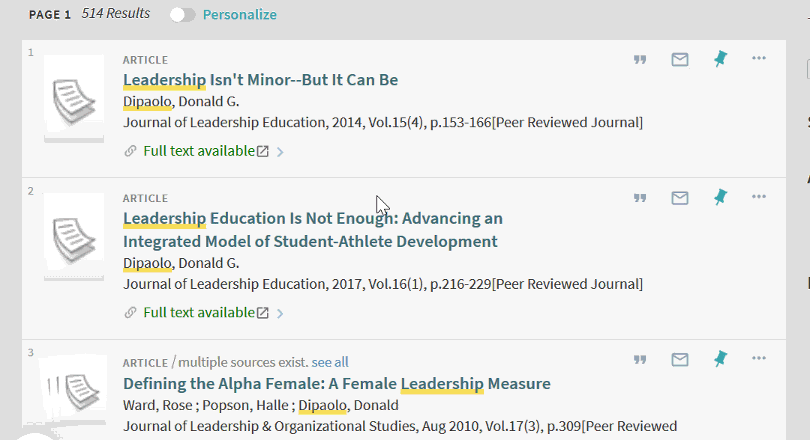
Next, highlight the text you want folks to click on to open the link (in the example below, "DiPaolo's leadership article" will be our link text), then click the link button in the toolbar, which looks like a couple links of chain.
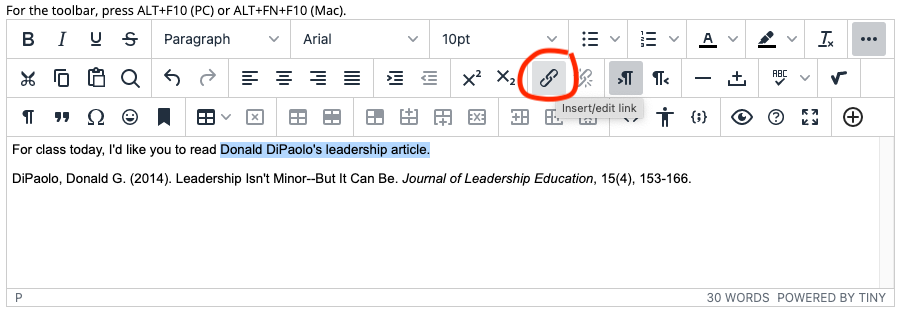
Paste (CTRL+V, CMD+V, or right click and paste) your link into the url field and click SAVE to add your link.
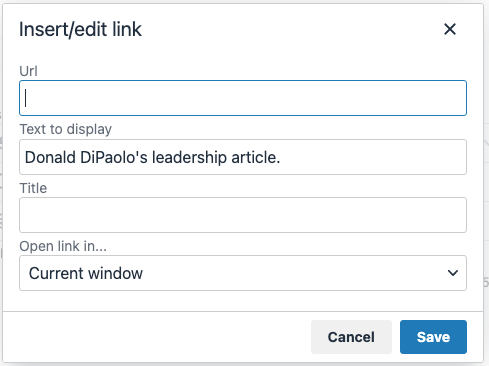
If you want to remove your link, re-highlight the link text and click the broken chain button.

Be sure to save your changes.
Remove a Link From a Text Box
If you want to remove your link, re-highlight the link text and click the broken chain button in the toolbar.

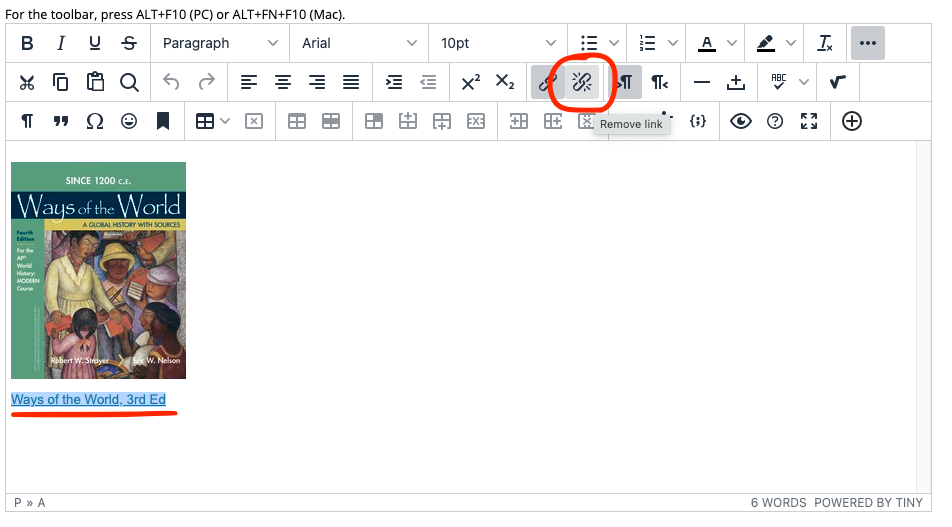
Be sure to save your changes.
Insert Local File in a Text Box
When you use the insert content button (instead of attach) the item becomes embedded in the text. Blackboard supports many different file types, including the standard .docx, .pdf, .pptx, .jpg, .png, etc. This page outlines the file types Blackboard supports.
Note: DO NOT insert or attach actual video files such as .mp4 or .mov as they consume excessive storage space. Please instead hyperlink or embed your captioned video on a
streaming service like Yuja which Detroit Mercy supports.
To insert a local file, first click the insert content button on the bottom right of the tool bar.
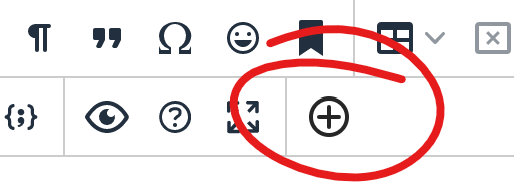
If your toolbar consists of a single row, click the three-dot "more" button to expand the toolbar.

This will open a pop-out window with multiple content options. Choose Insert Local Files.
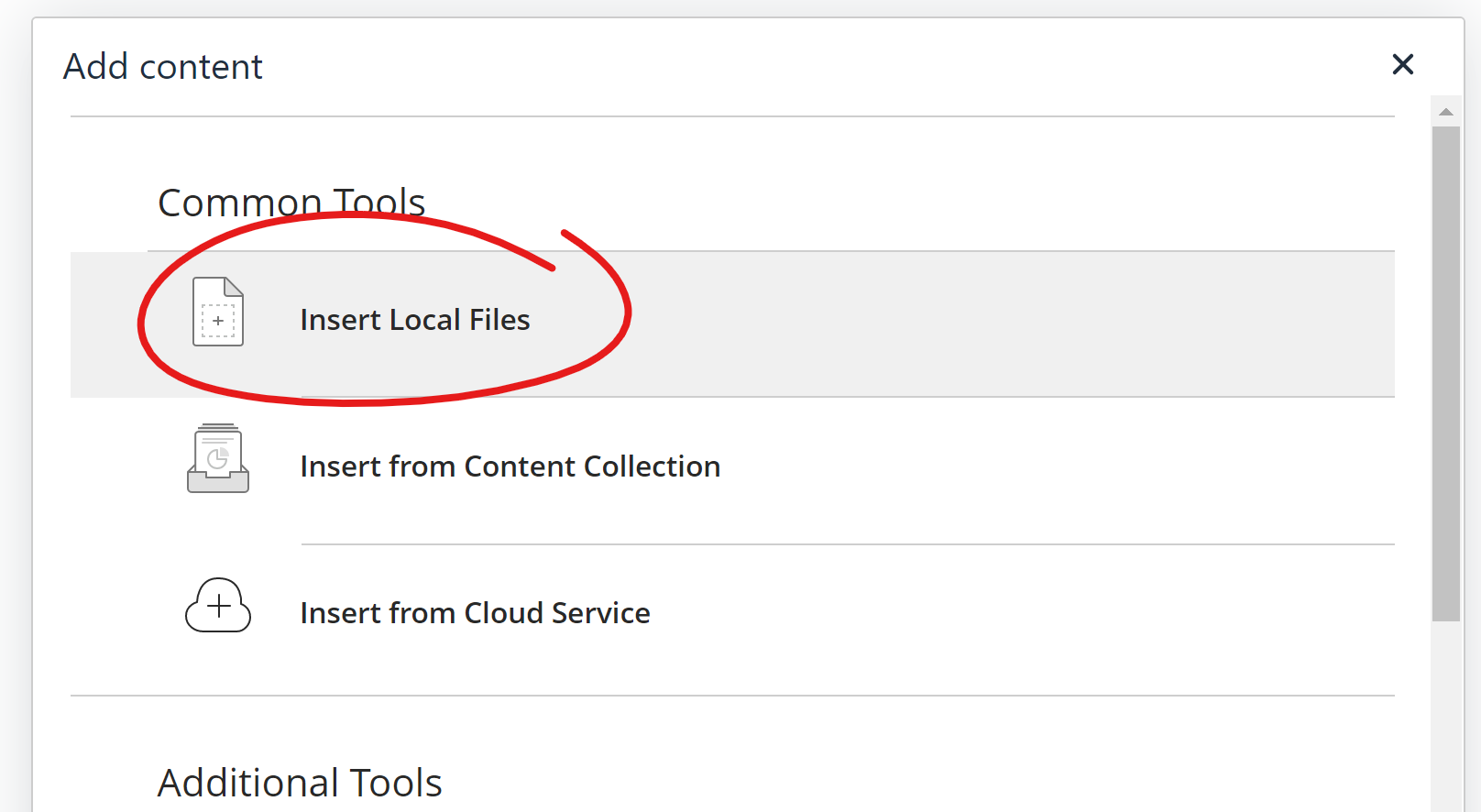
This will open your document storage (aka Finder on Mac and Windows Explorer on PC). Find the file you wish to insert. Select it and click Open.
Depending on the type of file, this will either:
A) embed a link to your document within the text box. Users will click that link to access the file, which will either open in a new tab/window or require download.
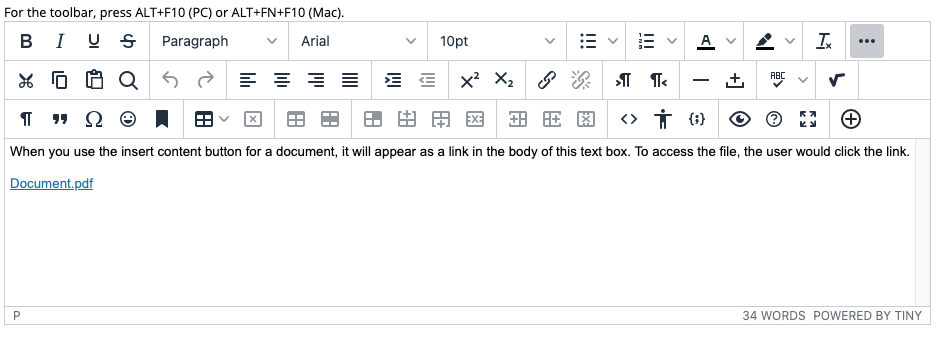
OR
B) embed an image within the text box which will most likely fill the space. To adjust the size of the image, click on it and a blue box will appear around the edges. Move your cursor to one of the corners. Click and drag that corner to resize to what you’d like.
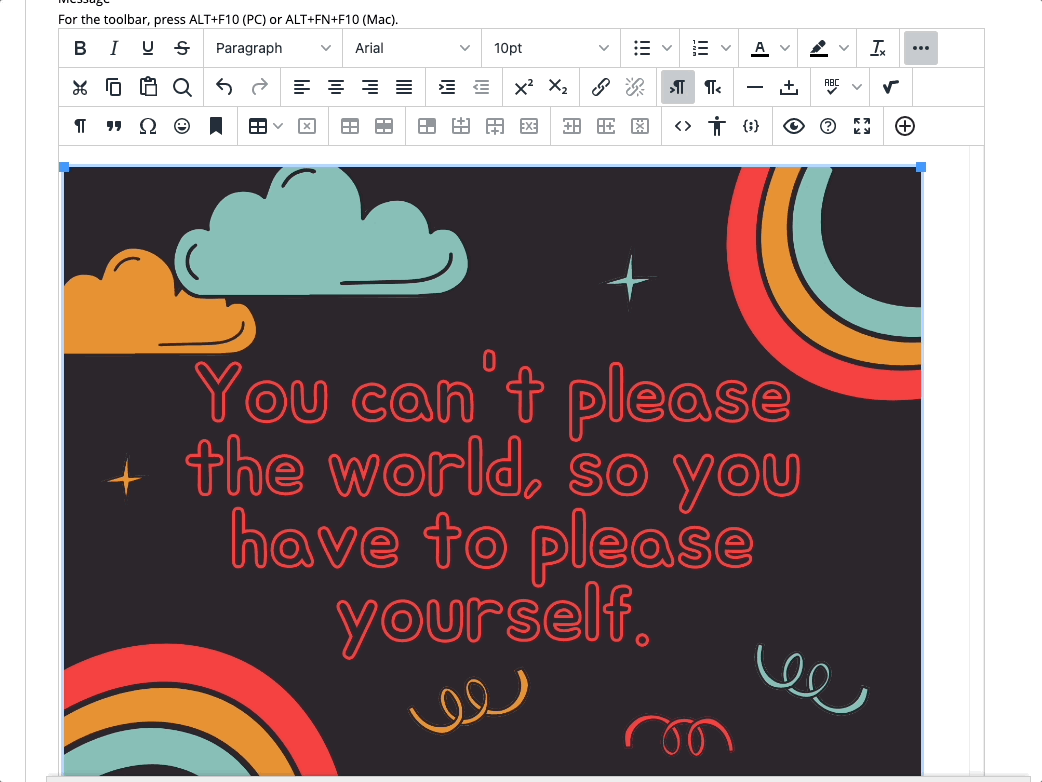
Be sure to save your changes.
Insert Cloud Storage File in Text Box
You can use a connected cloud storage services (OneDrive, Google Drive, Box, and Dropbox) to add files to your Blackboard. When you use the insert content button (instead of attach) the item becomes embedded in the text. Blackboard supports many different file types, including the standard .docx, .pdf, .pptx, .jpg, .png, etc. This page outlines the file types Blackboard supports.
Notes:
- This feature is currently NOT available when inserting an independent file or a file as part of announcement.
- DO NOT insert or attach actual video files such as .mp4 or .mov as they consume excessive storage space. Please instead hyperlink or embed your captioned video on a streaming service like Yuja which Detroit Mercy supports.
- You're still "uploading" files to Blackboard (so if you make changes to the originals you'll need to replace the old versions on Blackboard).
To insert a cloud-based file, first click the insert content button in the tool bar. 
(If you can’t find this button, first click the three dots button  ).
).
Then click Insert From Cloud Service.
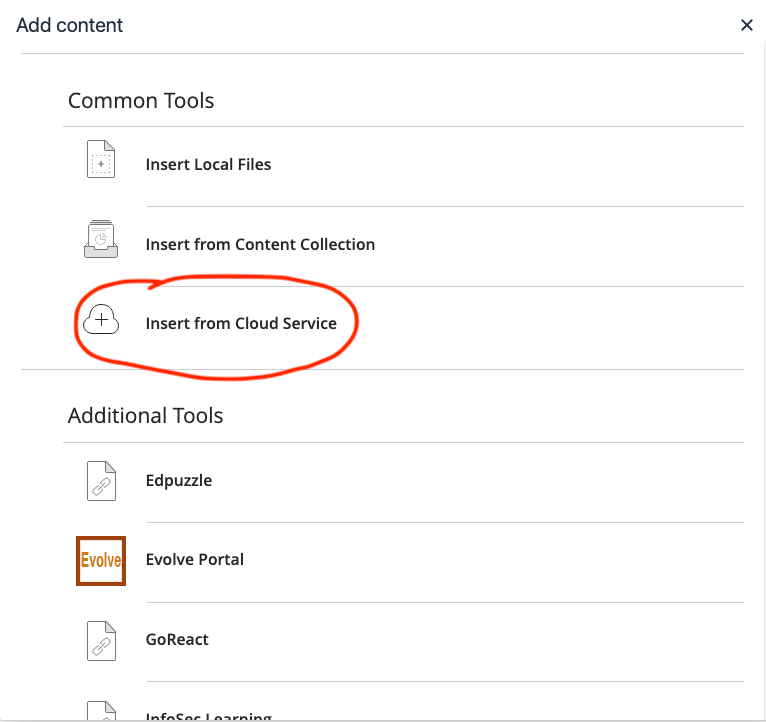
Choose the web app you want to connect to. Detroit Mercy provides and supports Microsoft OneDrive, but you are not required to use it.
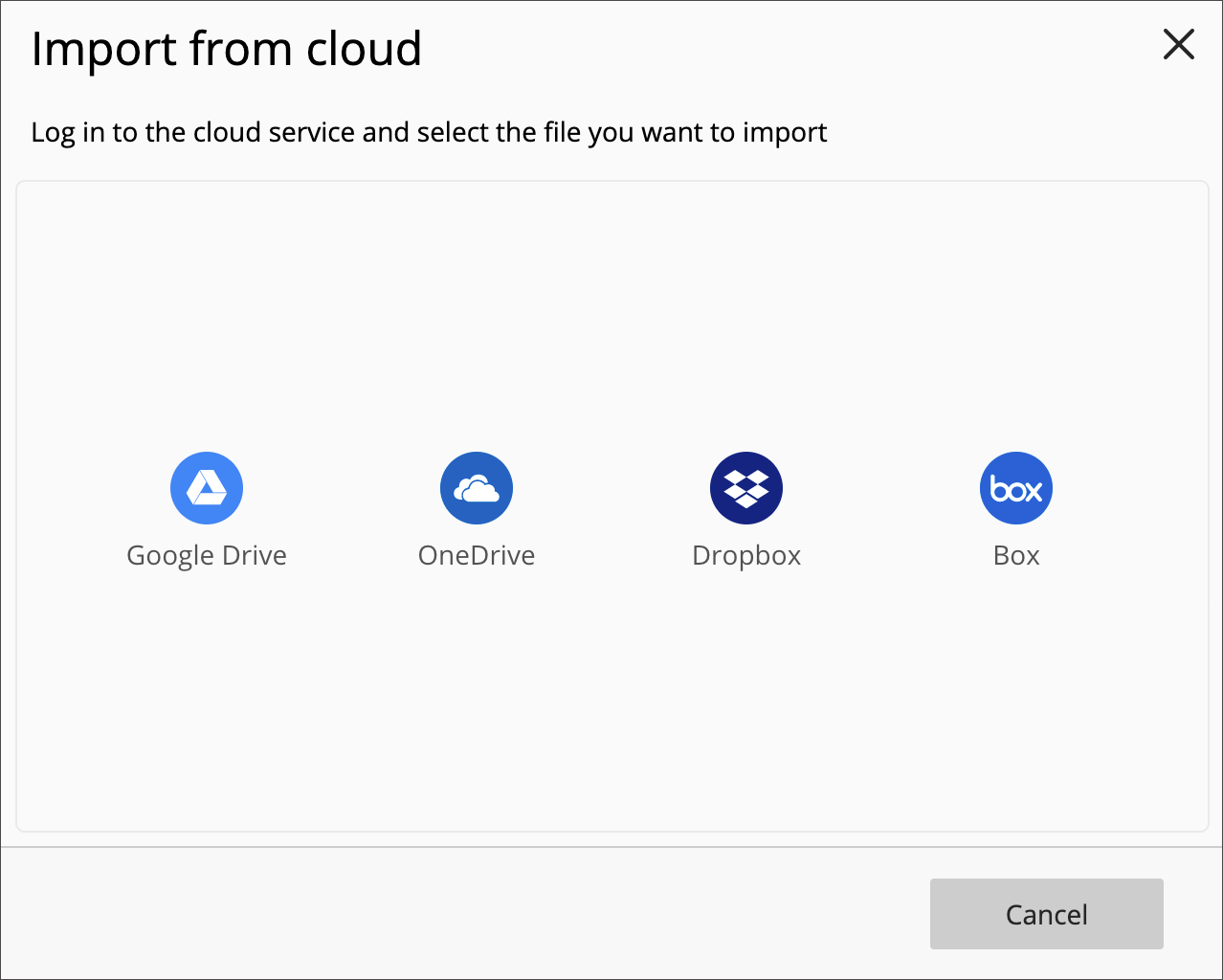
If you are already connected to your Cloud Storage, you will now see all of your OneDrive folders and files and can select what you would like.
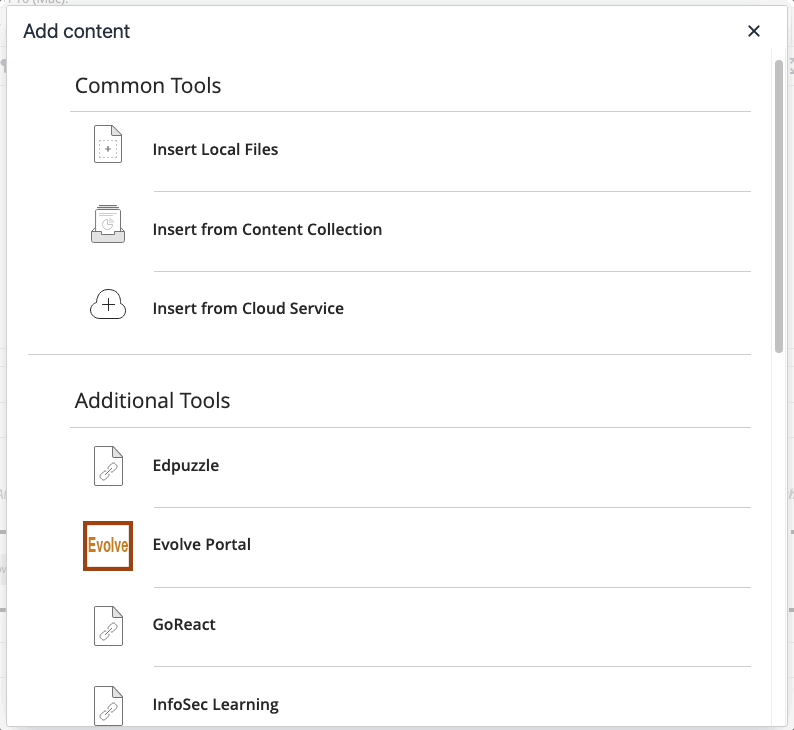
Depending on the type of file, this will either:
A) embed a link to your document within the text box. Users will click that link to access the file, which will either open in a new tab/window or require download.
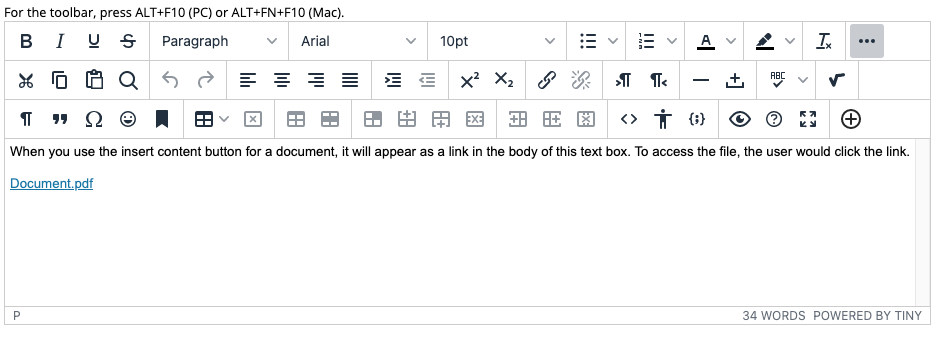
OR
B) embed an image within the text box which will most likely fill the space. To adjust the size of the image, click on it and a blue box will appear around the edges. Move your cursor to one of the corners. Click and drag that corner to resize to what you’d like.
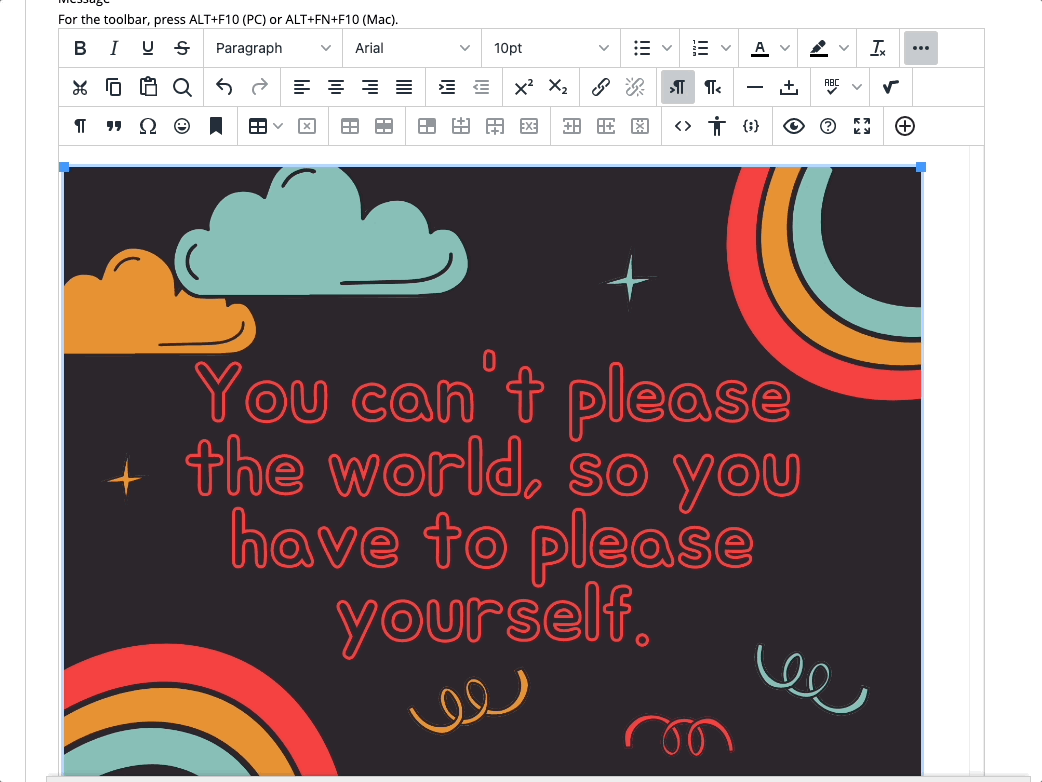
Be sure to save your changes.
In order to add text and other materials in Blackboard, the Text Editor is a necessary and common tool. There are some more frequently used options and techniques, beyond general font and style, which are included in this walkthrough. Below you will find steps to both add and remove a hyperlink and steps to insert a file or other media into the text box.
Add a Link to a Text Box
The Blackboard toolbar makes adding a link to the contents of any text box -- be it a discussion board post, announcement, anything -- very easy.
First you'll want to write your post or item which will include the link. Then, open a new browser tab (CTRL+T or CMD+T), and find and copy your URL. For this example, I've pulled the permalink to a journal article from the Library's catalog:
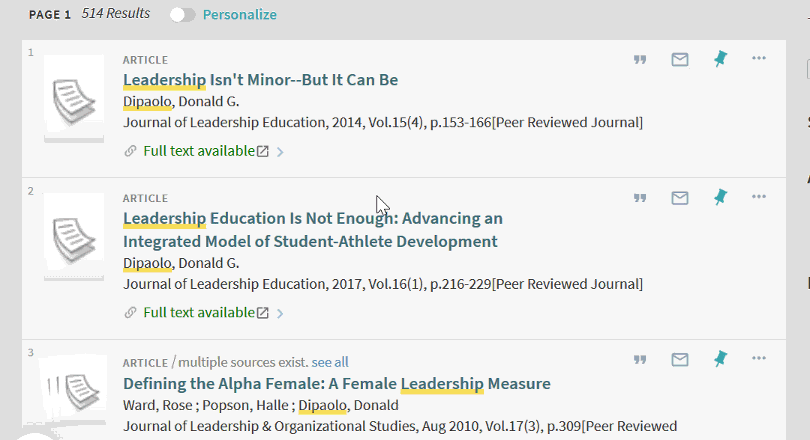
Next, highlight the text you want folks to click on to open the link (in the example below, "DiPaolo's leadership article" will be our link text), then click the link button in the toolbar, which looks like a couple links of chain.
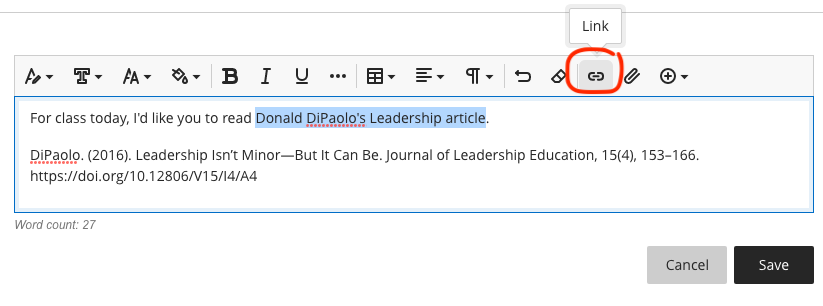
Paste (CTRL+V, CMD+V, or right click and paste) your link into the url field and click Insert to add your link.
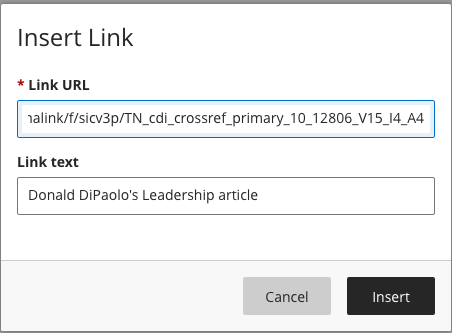
Be sure to save your changes.
Remove a Link From a Text Box
If you want to remove your link, re-highlight the link text and click the chain button in the toolbar.
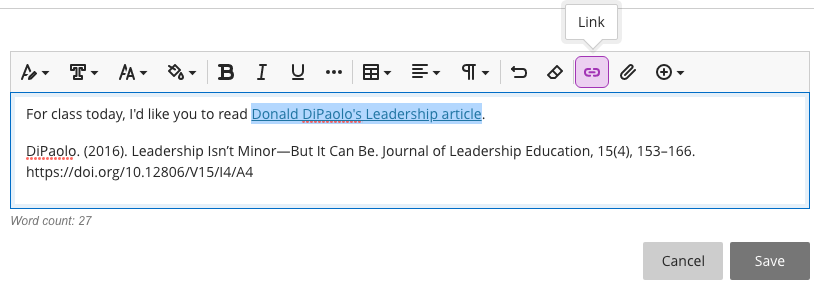
Highlight and delete the URL field contents.
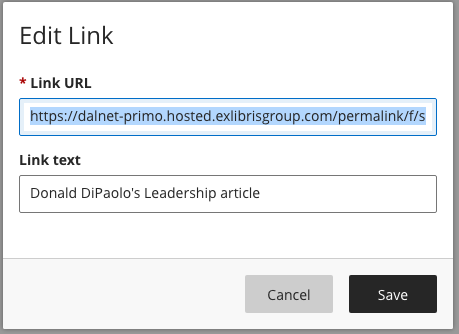
Click Save.
Be sure to save your changes.
Insert Local File in a Text Box
When you use the attach button in Blackboard Ultra, the item becomes embedded in the text. Blackboard supports many different file types, including the standard .docx, .pdf, .pptx, .jpg, .png, etc. This page outlines the file types Blackboard supports.
Note: DO NOT insert or attach actual video files such as .mp4 or .mov as they consume excessive storage space. Please instead hyperlink or embed your captioned video on a
streaming service like Yuja which Detroit Mercy supports.
To insert a local file, first click the attach button in the toolbar.

This will open your document storage (aka Finder on Mac and Windows Explorer on PC).
Find the file you wish to insert. Select it and click Open.
Depending on the type of file, this will either:
A) embed a link to your document within the text box. You will be given the option to change the Display Name for the file. You will also be given the options for how you wish users to works with your file: view only, download only, or both.
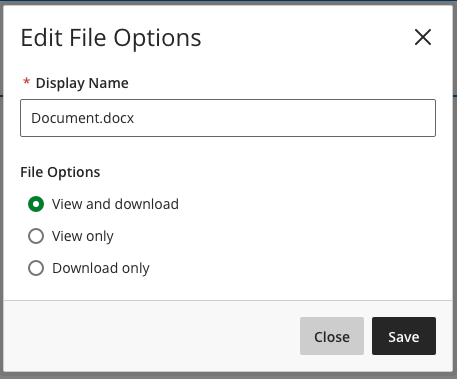

Users will click that link to access the file, which will either open in a new tab/window, preview on the main screen, or require download.
OR
B) embed an image within the text box. You will be given the option to change the Display Name for the file and to set Alternative Text (for the visually impaired). You will also be given the options for how you wish users to works with your file: view only, download only, or both.
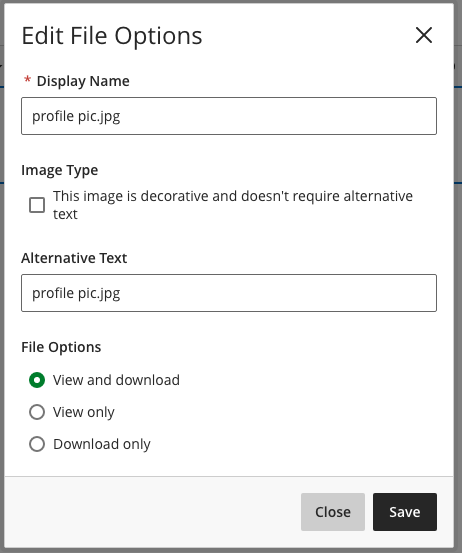
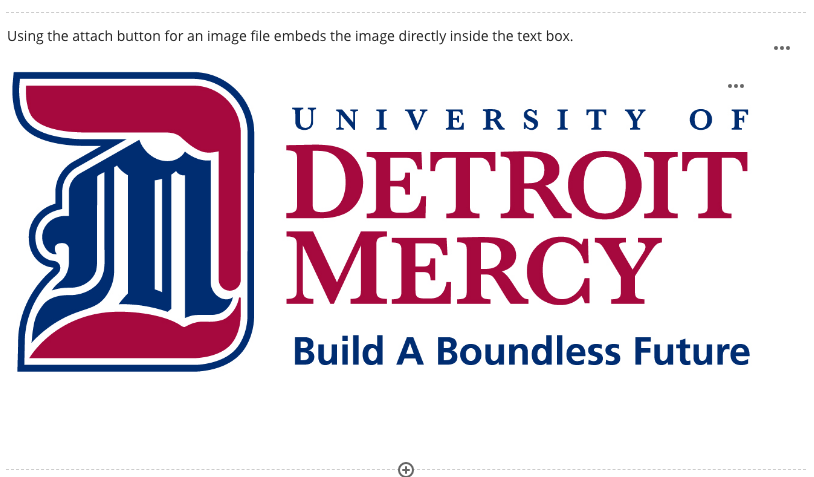
There is no current way to adjust the size of the image.
Be sure to save your changes.
Insert Cloud Storage File in Text Box
You can use a connected cloud storage services (OneDrive, Google Drive, Box, and Dropbox) to add files to your Blackboard. When you use the insert content button the item becomes embedded in the text. Blackboard supports many different file types, including the standard .docx, .pdf, .pptx, .jpg, .png, etc. This page outlines the file types Blackboard supports.
Notes:
- DO NOT insert or attach actual video files such as .mp4 or .mov as they consume excessive storage space. Please instead hyperlink or embed your captioned video on a streaming service like Yuja which Detroit Mercy supports.
- You're still "uploading" files to Blackboard (so if you make changes to the originals you'll need to replace the old versions on Blackboard).
To insert a cloud-based file, first click the insert content button in the tool bar.
Then click Cloud storage.
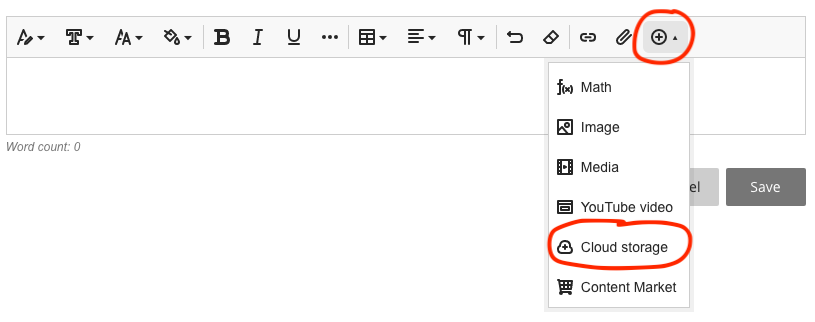
Choose the web app you want to connect to. Detroit Mercy provides and supports Microsoft OneDrive, but you are not required to use it.
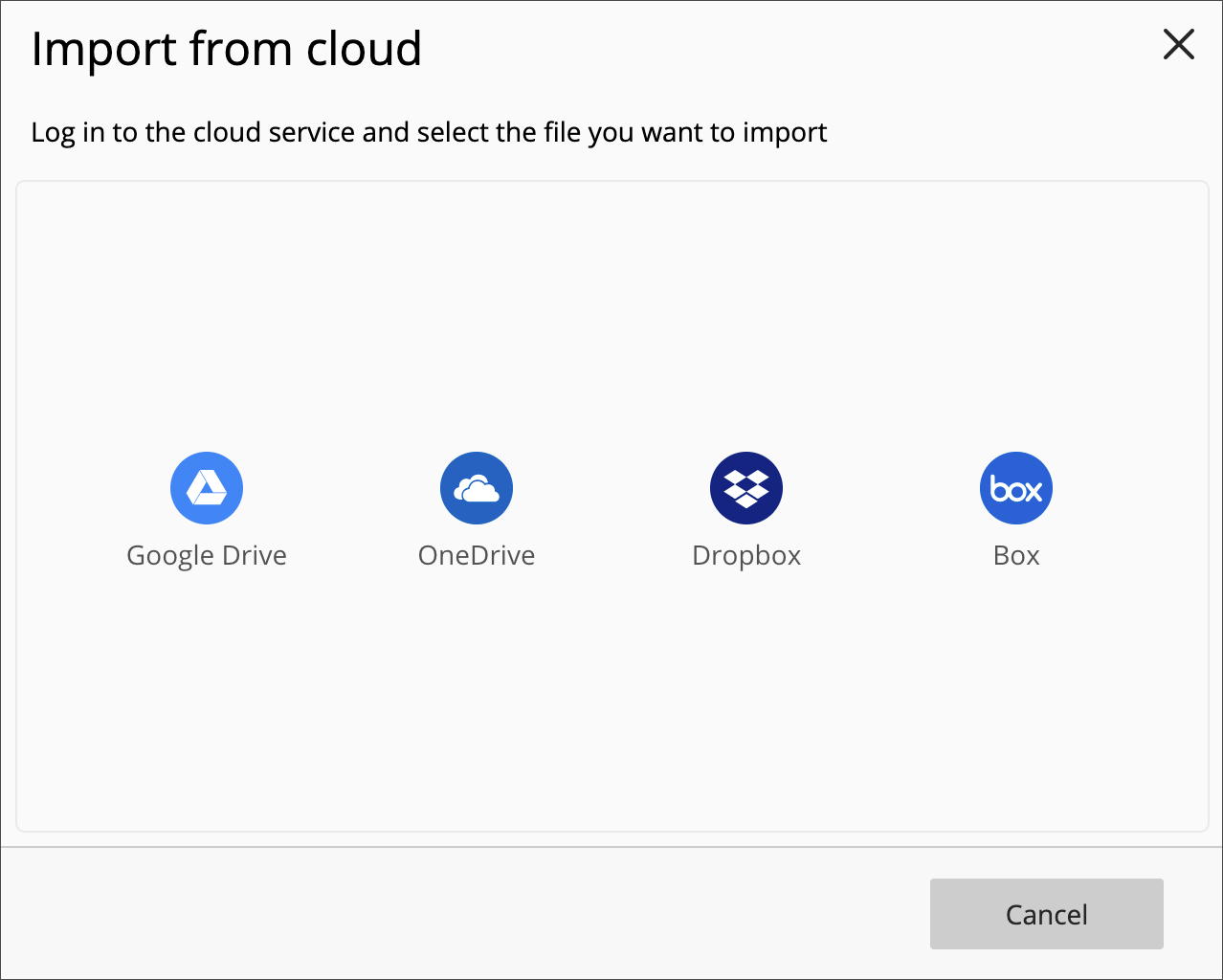
If you are already connected to your Cloud Storage, you will now see all of your OneDrive folders and files and can select what you would like.
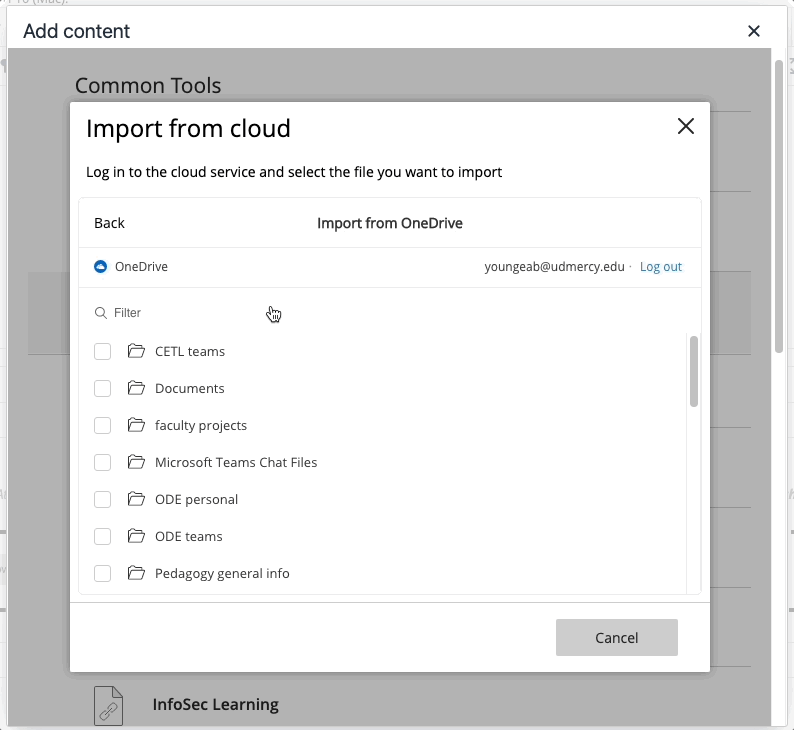
Depending on the type of file, this will either:
A) embed a link to your document within the text box. You will be given the option to change the Display Name for the file.

Users will click that link to access the file and be given the option to either view the file in the window or download it.

OR
B) embed an image within the text box. You will be given the option to change the Display Name for the file and to set Alternative Text (for the visually impaired). You will also be given the options for how you wish users to works with your file: view only, download only, or both.
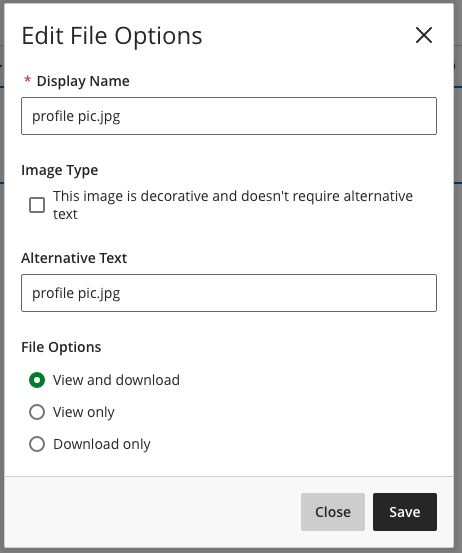
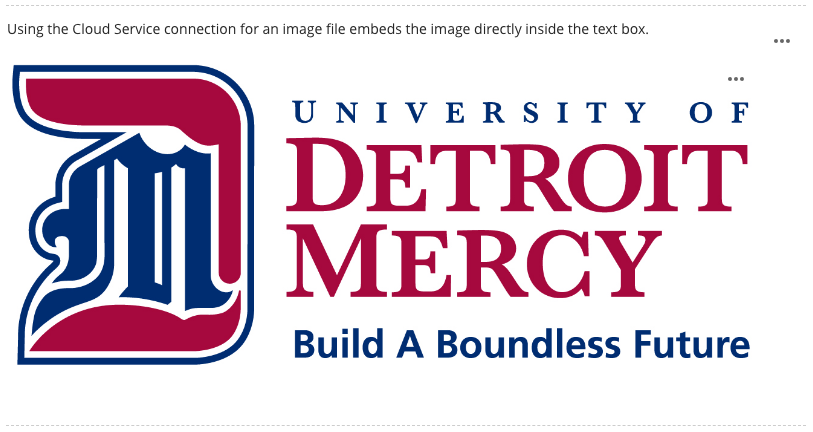
There is no current way to adjust the size of the image.
Be sure to save your changes.
Insert Other Media in a Text Box (Ultra)
You can embed Stream, YouTube, Prezi, Vimeo, SoundCloud, Spotify or other media on the page by pasting a share link. A full list of supported media can be found on this page.
Note: DO NOT insert or attach actual video files such as .mp4 or .mov as they consume excessive storage space. Please instead hyperlink or embed your captioned video on a
streaming service like Yuja which Detroit Mercy supports.
Choose the Insert Content button which is available anywhere you find the toolbar and text box.
Choose Media. (Note: use the Media button for YouTube videos, too, even though there is another button for YouTube—it does not work.)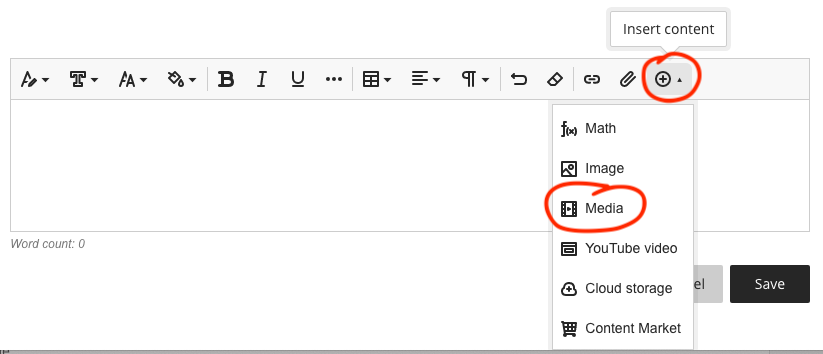
Open a new browser tab (CTRL+T or CMD+T), and find and copy your URL. For this example, I've pulled the Share link to a video on Microsoft Stream. (Reminder: MS Stream videos are only viewable to authorized users.)
Paste (CTRL+V, CMD+V, or right click and paste) your link into the Media URL field and click Insert to add your link. This is also a good time to add Alternative text for the visually impaired.

The video will now be embedded in your text box. Users will be able to watch the video without leaving the course site AND it won’t take up precious Blackboard storage space.
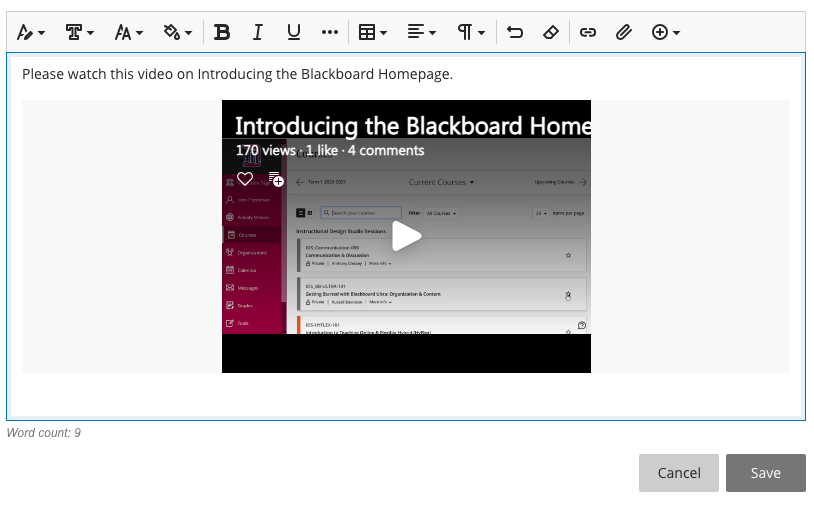
Be sure to save your changes.